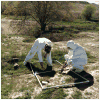Emerging issues, challenges, and changing epidemiology of fungal disease outbreaks
- PMID: 28774697
- PMCID: PMC5712439
- DOI: 10.1016/S1473-3099(17)30443-7
Emerging issues, challenges, and changing epidemiology of fungal disease outbreaks
Abstract
Several high-profile outbreaks have drawn attention to invasive fungal infections (IFIs) as an increasingly important public health problem. IFI outbreaks are caused by many different fungal pathogens and are associated with numerous settings and sources. In the community, IFI outbreaks often occur among people without predisposing medical conditions and are frequently precipitated by environmental disruption. Health-care-associated IFI outbreaks have been linked to suboptimal hospital environmental conditions, transmission via health-care workers' hands, contaminated medical products, and transplantation of infected organs. Outbreak investigations provide important insights into the epidemiology of IFIs, uncover risk factors for infection, and identify opportunities for preventing similar events in the future. Well recognised challenges with IFI outbreak recognition, response, and prevention include the need for improved rapid diagnostic methods, the absence of routine surveillance for most IFIs, adherence to infection control practices, and health-care provider awareness. Additionally, IFI outbreak investigations have revealed several emerging issues, including new populations at risk because of travel or relocation, occupation, or immunosuppression; fungal pathogens appearing in geographical areas in which they have not been previously recognised; and contaminated compounded medications. This report highlights notable IFI outbreaks in the past decade, with an emphasis on these emerging challenges in the USA.
Copyright © 2017 Elsevier Ltd. All rights reserved.
Conflict of interest statement
We declare no competing interests.
Figures
References
-
- Brown GD, Denning DW, Gow NA, Levitz SM, Netea MG, White TC. Hidden killers: human fungal infections. Sci Transl Med. 2012;4:165rv13. - PubMed
-
- Vallabhaneni S, Mody RK, Walker T, Chiller T. The global burden of fungal diseases. Infect Dis Clin North Am. 2015;30:1–11. - PubMed
-
- Chang DC, Grant GB, O’Donnell K, et al. Multistate outbreak of Fusarium keratitis associated with use of a contact lens solution. JAMA. 2006;296:953–63. - PubMed
Publication types
MeSH terms
Grants and funding
LinkOut - more resources
Full Text Sources
Other Literature Sources
Medical
Miscellaneous



